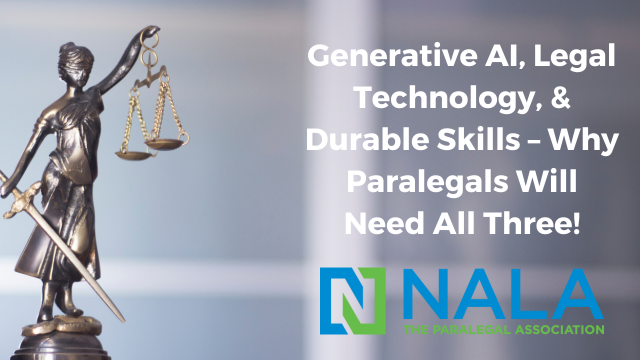
[Editor’s Note: Reprinted with permission of Sheila Grela and NALA – The Paralegal Association. This article originally appeared in the Q4 2023 issue of FACTS & FINDINGS, the quarterly journal of NALA. Inquiries should be directed to NALA, 6450 S. Lewis Avenue, Suite 250, Tulsa, OK 74136, or by email to nalanet@nala.org..The opinions and positions are those of the author.]
Predictions about generative AI fill social media and headlines. The dialogue ranges from fear to excitement, but the conclusion is that legal professionals cannot ignore AI. The press speculates on the potential loss of work. Does the suggestion that AI may reduce or eliminate paralegal work cause anxiety? Yes. Should it? No! Ultimately, AI will provide more work for savvy professionals.
The ABA placed a banner at a recent conference that asked for comments from attendees about their proclamation:
“Artificial Intelligence (AI) won’t replace lawyers anytime soon. Lawyers who use AI will replace lawyers who do not use AI.”
The banner should have read “legal professionals” instead of “lawyers.” It is well known that paralegals adapt to new technology amazingly well. Paralegals quickly adopted virtual meetings and conquered other new software and devices at the pandemic’s start. Preparing and informing fellow paralegals through practical education is a hallmark of NALA. Recently, the Florida State Bar added a requirement for three hours of continuing education in technology for each 3-year compliance period for Florida Registered Paralegals. Other states are expected to follow suit by requiring the completion of continuing education hours regarding technology for both paralegals and attorneys.
During my tenure as a litigation paralegal, I have seen a world of changes that have transformed the scope and method of my work. Most of these advances have been in conducting research, gathering information, and other time-consuming tasks. Understanding and adopting the technology and tools available can boost paralegal skills and increase value to a legal team.
During my tenure as a litigation paralegal, I have seen a world of changes that have transformed the scope and method of my work. Most of these advances have been in conducting research, gathering information, and other time-consuming tasks. Understanding and adopting the technology and tools available can boost paralegal skills and increase value to a legal team.
In 2022, technologist Cat Casey published the article “How I Learned to Stop Worrying and Love Legal AI,”1AI,” concluding that AI is not your enemy. I concur with her opinion that AI can make workers using it more valuable. Embracing technology will help paralegals perform more efficiently and focus on higher-value tasks. Cat Casey has championed legal AI for discovery (document review), practice management, and contract review.
How can you prepare for the challenges of AI? Some challenges are as simple as monitoring generative AI to avoid “AI hallucinations” and verifying the reliability of the content it generates. A highly well-known example of that problem in the headlines was attorneys providing fake citations in their brief to the Court through their unskilled use of ChatGPT. Addressing these concerns will require quality control and understanding of the limitations of this time-saving tool.
The first step in the process of educating yourself is admitting the barrage of information is daunting. Second, consider the source of items you read about AI. Many associations, vendors, and law firms have provided comprehensive white papers or articles that help cut through the scary headlines. EDRM.net published a white paper called “Professional Responsibility Considerations in AI for eDiscovery: Competence, Confidentiality, Privacy and Ownership.”2“Professional Responsibility Considerations in AI for eDiscovery: Competence, Confidentiality, Privacy and Ownership.” Businesses must consider the foundational issues of competence, confidentiality, privacy, and ownership when implementing the use of AI.
One such resource is EDRM.net, which provides information in various formats. For example, you can watch industry leaders discuss AI in webinars or podcasts. The website also includes content from multiple luminaries, such as Jerry Bui, Craig Ball, Ralph Losey, Doug Austin, and John Tredennick.
Also, the current knowledge base of paralegals will require additional training on the dangers and benefits of generative AI. One such resource is EDRM.net, which provides information in various formats. For example, you can watch industry leaders discuss AI in webinars or podcasts. The website also includes content from multiple luminaries, such as Jerry Bui, Craig Ball, Ralph Losey, Doug Austin, and John Tredennick.
The most recent development in AI is detailed in an article by Stephanie Wilkins entitled, “MIT Task Force Proposes Principles for the Responsible Use of Generative AI in Legal.” 3“MIT Task Force Proposes Principles for the Responsible Use of Generative AI in Legal.” The Task Force “believes [generative AI] provides powerfully useful capabilities for law and law practice and, at the same time, requires some informed caution for its use in practice.” Recently, the Task Force released an early version of seven draft principles that establish a lawyer’s duties when using AI for legal work. These seven principles were adapted from the ABA Rules of Professional Conduct4ABA Rules of Professional Conduct and the United Nations Principles for the Role of Lawyers.5United Nations Principles for the Role of Lawyers.
All seven of these items are categorized as duties:
1. Duty of Confidentiality to the client in all usage of AI applications;
2. Duty of Fiduciary Care to the client in all usage of AI applications;
3. Duty of Client Notice and Consent to the client in all usage of AI applications;
4. Duty of Competence in the usage and understanding of AI applications;
5. Duty of Fiduciary Loyalty to the client in all usage of AI applications;
6. Duty of Regulatory Compliance and respect for the rights of third parties applicable to the usage of AI applications in your jurisdiction(s);
7. Duty of Accountability and Supervision to maintain human oversight over all usage and outputs of AI applications.
The implementation of AI includes strong concerns regarding ethics, including bias. Significantly, the issue of bias (in regards to racial equity and support for underserved communities) was addressed by an Executive Order6Executive Order on February 16, 2023. One embedded principle discussed is “equitable data” and the need for “government programs and policies to yield consistently fair, just, and impartial treatment of all individuals.”
A caveat, then, with AI is that its reliability for such uses has not been tested. Also, the complexity of many problems requires individuals to solve them. AI can provide facts, but humans must analyze those facts for follow-up research or interview witnesses to gain insight into the facts of the pending case or scenario.
There will always be a need for paralegals because AI does not create, conceptualize, or plan strategically. It cannot empathize with the scared or confused client when it emails those interrogatory questions.
There will always be a need for paralegals because AI does not create, conceptualize, or plan strategically. It cannot empathize with the scared or confused client when it emails those interrogatory questions. Within the legal realm, who will step in to fill the need for technologists to have the ability to understand and use generative AI? Not surprisingly, it is anticipated that paralegals will. The technological potential of AI to automate tedious and time-con- suming tasks will allow legal teams to concentrate on the array of legal challenges their clients face. This would include more sophisticated, far-reaching projects. It is hoped that AI will allow internal and external legal teams to determine how paralegals are underutilized. More high-value projects and career enhancement may result. Clients, especially insurance companies and corporate clients, are demanding leaner budgets and invoices through the use of paralegals, whose hourly rate is lower than other legal team members.
In addition to the legal community, the surge of concern regarding the future of multiple professions has been the subject of many articles. The article from Harvard Business Review7Harvard Business Review on this subject provided insight and listed challenges. The general approaches for fortifying your career include:
- Avoid Predictability.
- Hone the skills that machines strive to emulate.
- Double down on “the real world.”
- Develop your personal brand.
- Cultivate expertise.
The ability to “hone the machine skills” comes from concentrating on the durable skills that make paralegals invaluable. America Succeeds uses the phrase “Durable Skills” for their classification of soft skills and character skills, such as fortitude and leadership. Increasingly, job ads have asked for critical thinking, leadership, and communication skills in their candidates. The legal ads include durable skills as requirements, and there is statistical support for this assertion. Over 80 percent of the job ads for legal professionals include at least one durable skill, and 69 percent of the ads include two or more.
The increase in the use of legal technology has challenged paralegals to master new tools and upgrade their skills, enabling them to work smarter, not harder. In summary, paralegals must maintain competency in legal technology, which will reward them with increased career security and satisfaction.
Resources:
1 https://resource.revealdata.com/en/blog/how-i-learned-to-stop-worrying- and-love-legal-ai
2 https://edrm.net/2023/06/professional-responsibility-considerations-in-ai- for-ediscovery-competence-confidentiality-privacy-ownership/
3 https://www.law.com/legaltechnews/2023/08/03/mit-task-force-proposes- principles-for-the-responsible-use-of-generative-ai-in-legal/ and https://law. mit.edu/ai
4 https://www.americanbar.org/groups/professional_responsibility/ publications/model_rules_of_professional_conduct/model_rules_of_ professional_conduct_preamble_scope/
5 https://www.ohchr.org/en/instruments-mechanisms/instruments/basic- principles-role-lawyers
6https://www.whitehouse.gov/briefing-room/presidential- actions/2023/02/16/executive-order-on-further-advancing-racial-equity-and- support-for-underserved-communities-through-the-federal-government/
7 https://hbr.org/2023/04/5-ways-to-future-proof-your-career-in-the-age-of-ai
Author Biography

Sheila Grela, ACP, is a seasoned litigation paralegal who obtained a paralegal certificate with honors from the ABA-approved USD Paralegal Program. Sheila has advanced her paralegal training by becoming both a Certified eDiscovery Specialist (CEDS) and an Advanced Certified Paralegal (ACP®) in eDiscovery. She was appointed to be a Global Advisory Council participant for the Electronic Discovery Reference Model (EDRM) in 2020. Sheila is a fierce advocate for training, education, mentorship, and professional development for the paralegal community. She is heavily involved in the California Alliance of Paralegals (CAPA), the San Diego Paralegal Association (SDPA), and the San Diego chapter of Women in eDiscovery.
Email: grelasheila@gmail.comSheila.Grela@procopio.com
Notes
- 1AI,”
- 2“Professional Responsibility Considerations in AI for eDiscovery: Competence, Confidentiality, Privacy and Ownership.”
- 3“MIT Task Force Proposes Principles for the Responsible Use of Generative AI in Legal.”
- 4ABA Rules of Professional Conduct
- 5United Nations Principles for the Role of Lawyers.
- 6Executive Order
- 7Harvard Business Review

